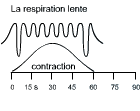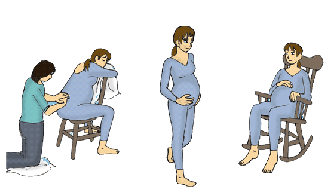Guide to Labour and Delivery
1. Early Labour
First Stage
| 1. Early Labour | ||
|
What is happening |
How you may feel |
|
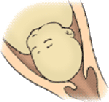 |
The cervix is thinning and opening from 1 cm to about 4 cm. The contractions
A pinkish mucous (mucous plug) comes out of the vagina. Sometimes this happens sooner. Your waters may break. You may need to urinate more often or have diarrhea. |
Excited Relieved that labour is beginning Afraid Talkative Anxious for the birth of the baby
|
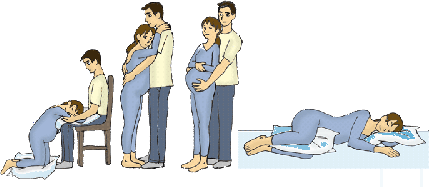 |
||
| What you can do | How a labour partner can help |
|
Carry on with your usual activities. Stay upright as long as possible. Walk. If your waters have not broken, shower or relax in a warm tub. Rest. At night, sleep if you can. Go to the bathroom as often as you need to. Eat and drink as you feel the need; it is important to maintain your energy. Even if you don't feel hungry, try to eat a light meal and be sure to get enough to drink. Breathe normally until walking or talking during a contraction becomes uncomfortable. Then, begin deep breathing as you need it. Go to the hospital when your contractions are coming regularly and about 5 minutes apart for a first child or 10 minutes apart if this is not your first child. You may call the hospital for advice. Go to the hospital immediately if your waters break. |
Stay with her. Encourage her. Help her to walk, relax, rest, and pass the time. Remind her to go to the bathroom. She will feel better if her bladder is empty. Encourage her to eat and drink. Time her contractions. Help her during her contractions.
Make sure that her suitcases are packed and ready to take to the hospital. Call the doctor and take her to the hospital when it is time. |
| Previous | Next |
| Guide to Labour and Delivery | 2. Active Labour |
2. Active Labour
First Stage
| 2. Active Labour | ||
|
What is happening |
How you may feel |
|
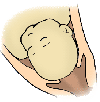 |
The cervix is opening to about 4 cm to 8 cm. The contractions
The vaginal discharge increases and becomes heavy and dark. Your water may break if it hasn't already done so. You may have some nausea, leg cramps, or back pain. You may sweat a lot. |
Tired Calm Tense Discouraged Serious Interested only in labour
|
| at you can do | How a labour partner can help |
|
Concentrate. Focus on breathing and relaxation. During contractions
Between contractions
|
Stay with her. Talk to her. Encourage her. Tell her how well she is doing. Time the contractions. Help her through contractions. Breathe with her. Help her to focus and concentrate. Use comfort measures — massage, backrubs, and cool cloths to her forehead. Help her to move and to find comfortable positions. Offer her ice and clear liquids. Help her use Vaseline or chap stick if her lips are dry. Encourage her to relax and rest between contractions. |
| Previous | Next |
| 1. Early Labour | 3. The Transitional Phase |
3. The Transitional Phase
First Stage
| 3. The Transitional Phase | ||
|
What is happening |
How you may feel |
|
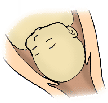 |
Your cervix is opening from about 8 cm to 10 cm. The contractions
You may feel great pressure on your rectum or vagina. You may feel nauseous or even throw up. You may have leg cramps, shaking, or back pain. Your face may be flushed and sweaty. You may have cold feet. Between contractions, you may feel drowsy. |
Distressed Overwhelmed Exhausted Restless Surprised by the urge to push Confused when told not to push Irritable to doctor, nurse, or partner Difficulty relaxing and breathing
|
| What you can do | How a labour partner can help |
|
Concentrate. Focus on breathing and relaxation. Think about how close you are to holding and seeing your baby. Change position often. Drink clear liquids Suck on ice chips, sour candy, or a wet washcloth if your mouth feels dry. During contractions
Between contractions
|
Stay with her. Talk to her. Encourage her. Tell her how well she is doing. Remind her that transition is difficult but short. It means that labour is almost over. Help her to stay calm and relaxed by staying calm and relaxed yourself. Time the contractions. Help her to focus and concentrate. Help her through contractions. Breathe with her. If necessary, take her face in your hands and look into her eyes. Tell her, "Look at me. Breathe With me." Remind her not to push too soon. Help her to pant and blow until the urge to push passes. Give her clear and simple directions. Use comfort measures - massage, back rubs, cold packs to her forehead. Place a warm, wet washcloth against her perineum (the area around her vagina). This will help her to relax and release her pelvic floor muscles. Help her to move and to find comfortable positions. Offer her ice and clear liquids. Help her to use Vaseline or chap stick if her lips are dry. Offrez-Lui de la glace et des liquides clairs. Aidez-la à se mettre de la vaseline ou du baume si ses lèvres sont sèches. |
| Previous | Next |
| 2. Active Labour | 4. Delivery |
4. Delivery
Second Stage
| 4. Delivery | ||
|
What is happening |
How you may feel |
|
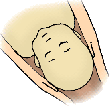 |
Your cervix is fully opened and your uterus is beginning to push the baby down through your vagina. The contractions
You may have strong urge to push with the contractions. You may feel yourself grunting ou making noises while pushing. You may feel a pressure in your rectum and groin as the baby moves down in the vagina. When the crown of the baby's head can be seen, you may have a burning feeling. Your back pain may go away at this time. |
Excited Impatient Tired Relieved Overwhelmed by the urge to push Amazed at the effort of pushing Drowsy and peaceful between contractions |
 |
||
| What you can do | How a labour partner can help |
|
The nurse or doctor will ask you not to push until your cervix is fully opened. When you are asked not to push, blow out until the urge passes. When your cervix is fully opened (10 cm), the nurse or doctor will tell you to push when you feel the urge. Pushing may feel very good if your perineum is relaxed. When you push
|
Talk to her. Support her. Praise her. Help her to imagine the baby moving down the birth canal. Help her find a comfortable position for pushing. Hold and support her in this position. Help her curl forward while pushing. Breathe with her. Help her to pant and blow when she is asked not to push. Let her know that it is OK to make noises. Massage to help her relax. Remind her to keep her pelvic floor muscles relaxed. Tell her when you can see the baby's head. She may want to touch it so she can believe that it is nearly here. Welcome the baby into the world! |
| Previous | Next |
| 3. The Transitional | 5. Delivery of the Placenta |
5. Delivery of the Placenta
Third Stage
| 5. Delivery of the Placenta | ||
|
What is happening |
How you may feel |
|
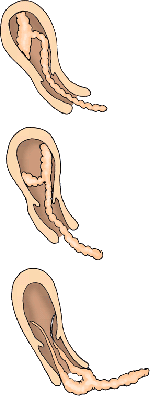 |
After the baby is born, your uterus rises in your abdomen and becomes round and about the size of a grapefruit. The doctor will give you an injection to help the uterus contract. Putting the baby to your breast will also help the uterus to contract. The doctor ou nurse may support your abdomen as the placenta comes out. There may be a gush of blood as the placenta comes out. If you have had an episiotomy, the local anesthetic will still be working; therefore, it won't hurt to get the stitches. |
Excited, thrilled Happy, grateful, and relieved Proud and fulfilled Tearful Hungry and thirsty Exhausted Absorbed by the baby and looking for assurance that he or she is OK |
| What you can do | How a labour partner can help |
|
Relax Push the placenta out if asked to Relax, cuddle, and enjoy your baby and your new family Breastfeed your baby
|
Assure the mother that the baby is fine. Offer her something to drink. Hold, cuddle, and enjoy the baby together. Share your feelings. You may feel overwhelmed with emotions. You may feel joy, exhausted, tearful, and relieved that it is over. Pat yourself on the back for a job well done. |
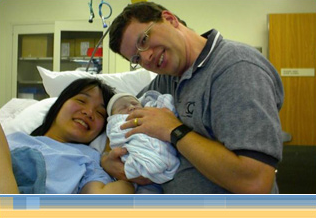 |
|
| Previous | |
| 4. Delivery | |
